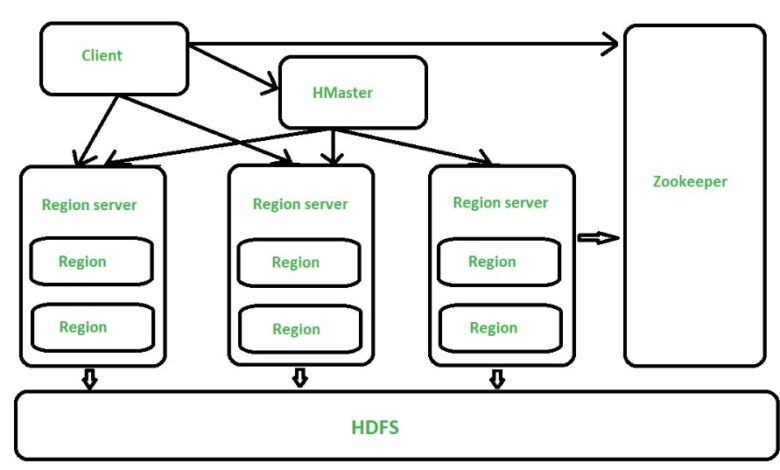How HMaster Balances Load and Ensures Data Distribution in HBase?

When using HBase to manage massive datasets across numerous servers, effective data distribution and load balancing are crucial for system performance optimization. In HBase’s distributed architecture, the HMaster server plays a pivotal role as the principal server in charge of allocating regions to RegionServers and ensuring that data is dispersed evenly. HMaster’s responsibilities extend beyond initial setup; it keeps tabs on workloads and system health, therefore optimizing processing by dynamically modifying region assignments. When it comes to data-intensive applications, which often experience high-demand situations, this blog delves into how HBase’s functionality is improved by HMaster’s balancing and distribution capabilities. This, in turn, ensures high availability, scalability, and smooth operation.
What Makes Load Balancing Crucial in HBase
Overview of Load Balancing in Distributed Databases
Distributed databases, such as HBase, use load balancing to keep system responsiveness and performance high by distributing data workloads evenly across all servers. Nodes (or servers) in a distributed system handle requests for areas of data that are specific to them. Certain nodes may experience delays, resource strain, or system crashes due to excessive workloads if load balancing is not effective. Distributed databases may dynamically manage and spread data loads with the help of load balancing, which in turn maximizes network resource efficiency, makes applications and users’ experiences more dependable, and speeds up their processing times.
Common Load Distribution Challenges in HBase
Because data access is concentrated in certain areas, or “hotspots,” HBase has a hard time distributing its workload evenly. In an HBase cluster, hotspots arise when a large number of users or applications access the same small area of data, which causes the load to be unequal and slows down the system as a whole. HMaster overcomes these difficulties by keeping an eye on traffic and redistributing high-demand regions on the fly to keep individual RegionServers from going down. With the use of specific load balancing algorithms, HMaster handles the continual adjustments needed to assign regions to HBase, including hotspots, as a result of changing traffic patterns, data expansion, and varied server capacity.
How Load Balancing Impacts HBase Performance
To make sure the database can handle large traffic without delays, HBase’s load balancing is efficient, which has a direct impact on system performance. By distributing the workload across multiple servers, HMaster keeps latency to a minimum and improves the speed with which data queries return results. The system remains quick and responsive regardless of fluctuations in demand since HMaster routinely reallocates busy regions to less-loaded servers, hence maintaining consistent processing rates. This balance makes the system more dependable and scalable by preventing performance bottlenecks, reducing data-access time, and ensuring that HBase can handle data-intensive operations.

How Does HMaster Handle Load Balancing
Assignment of Regions to RegionServers
Ensuring balanced data distribution in HBase relies on HMaster’s fundamental function: assigning data regions to RegionServers. By allocating regions during system startup, HMaster prevents any one RegionServer from becoming overwhelmed. As conditions change, it reassigns areas dynamically while keeping a constant eye on the workload of each RegionServer. To avoid problems caused by resource pressure on individual nodes, HMaster is able to efficiently distribute the data workload across RegionServers. Actively controlling region assignments allows HMaster to maintain system stability and maximize HBase’s performance capabilities under different load circumstances.
Monitoring RegionServer Health and Status
For optimal operation of the HBase cluster, HMaster continually monitors the status and performance of each RegionServer. When there are problems with the performance or uptime of RegionServers, HMaster can detect them through its constant monitoring and take preventative measures. As soon as a server starts to exhibit symptoms of overload, HMaster will transfer its regions to other RegionServers in order to forestall the server’s possible failure. In order to keep HBase running at peak efficiency, HMaster uses this health monitoring feature to respond rapidly to abnormalities, balance the cluster, and reduce downtime.
Detecting and Reassigning Hotspot Regions
When certain areas of data have disproportionately high access rates, a phenomenon known as “hotspot regions” develops and performance degrades. HMaster can identify these areas of high traffic by comparing regional patterns. In order to alleviate performance issues, HMaster quickly redistributes the impacted regions over numerous RegionServers once hotspots are detected. By proactively reassigning resources, we may reduce server load and avoid delays in data access. When specific data areas experience a surge in activity owing to user demand, HBase will continue to respond quickly because HMaster distributes the access loads across the RegionServers.
How Does HMaster Ensure Efficient Data Distribution
Splitting and Merging Regions Dynamically
HMaster’s ability to dynamically merge or separate zones is crucial for managing data size and access speeds. For a more even distribution of data or more users accessing specific regions, HMaster partitions big regions into smaller ones and distributes them among RegionServers. The same logic applies when merging zones with low activity or data quantities; the goal is to conserve resources. By allowing users to change area sizes in real time, HBase can make the most optimal use of its storage resources. In order to enhance cluster performance and prevent resource strain, HMaster dynamically balances data across the system.
Optimizing Data Locality Across RegionServers
Data proximity, or keeping data close to the processing server, has a major influence on how fast and efficient HBase is. By distributing regions to RegionServers, which already hold data, HMaster maximizes data locality and minimizes network data transit. Moving the processing of data closer to its storage location reduces latency and maximizes server efficiency. Improving HBase’s overall performance is essential, especially when working with high-demand applications and huge datasets. HMaster accomplishes faster data access times by focusing on data localization in area assignments.
Rebalancing Data During Server Failures
Quickly reassigning data regions to active RegionServers, HMaster ensures that data access remains uninterrupted in the case of a server loss. By moving regions from inactive to active RegionServers, this rebalancing keeps things running smoothly and reduces the effect of server outages on data availability. When one or more servers have problems, HMaster’s failover mechanism quickly reallocates the system’s data distribution to ensure high availability and reliability. Supporting HBase’s resilience, HMaster quickly rebalances regions in the event of failure, guaranteeing that the system keeps running smoothly even when servers go down.
Conclusion
The effectiveness of load balancing and data distribution—which are directly impacted by performance, scalability, and adaptability—are ensured by HMaster’s function in HBase. By implementing features like hotspot identification, dynamic data redistribution, and area assignment, HMaster ensures that HBase consistently and efficiently handles huge datasets and high traffic. By preventing server overloads, optimizing data locality, and redistributing data in response to load changes or server failures, hmaster maintains HBase’s reliability and speed. These balancing techniques are crucial for organizations seeking a scalable, resilient database infrastructure capable of supporting growing data requirements in today’s data-intensive applications.






